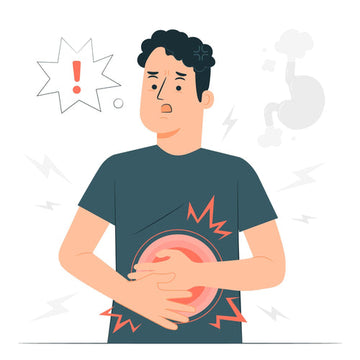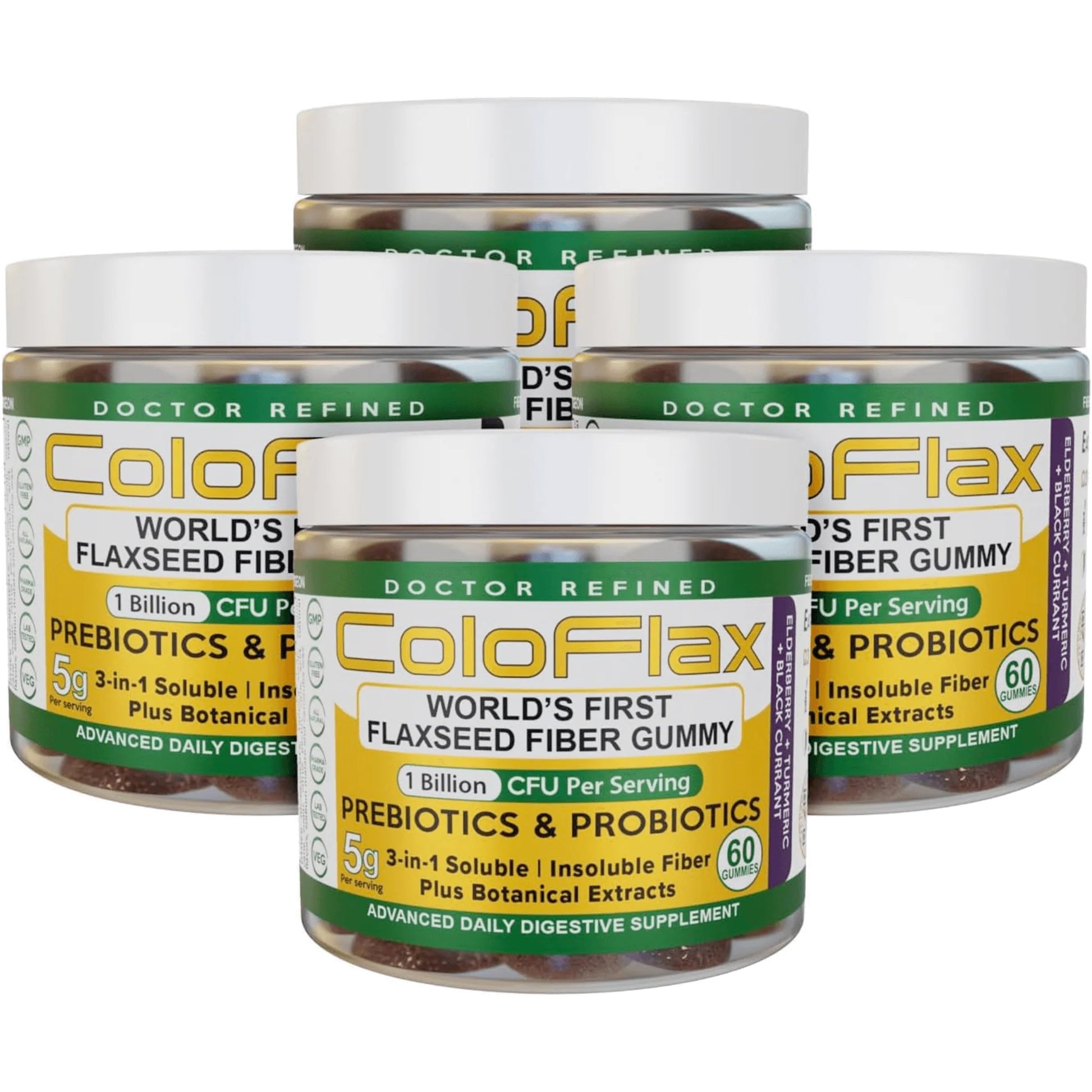Fiber is essential for optimal digestive health, but as with everything, it’s possible to overdo it. So, what happens when you eat too much fiber and how can you reduce those symptoms so you can continue to eat a fiber-rich diet?
What is the Optimal Fiber Intake?
Estimates suggest that as few as 5% of Americans are getting enough fiber. It’s an incredible statistic when you consider that low fiber has been linked with a host of health conditions.(1)
Recommended fiber intake typically falls between 18 and 38 grams per day, with the exact figure depending on your gender, age, and size.
Here is a quick guideline to help you:
- Men (Under 50) = 38g
- Men (Over 50) = 30g
- Women (Under 50) = 25g
- Men (Over 50) = 21g
- Children (1 to 3) = 19g
- Children (4 to 8) = 25g
- Children (9 to 13) = 26g for girls; 31g for boys
- Children (14 to 18) = 26g for girls; 38g for boys
The 5% figure quoted above doesn’t apply worldwide. Americans are not the worst when it comes to meeting fiber needs, but we’re far from the best. In Africa, for instance, many people eat over 50 grams of fiber a day, and in countries like Ghana, 43% are getting enough fiber.(2)
Can You Eat Too Much Fiber?
It is possible to consume more fiber than your body can comfortably handle. How much is “too much” is not an easy question to answer, though.
As noted above, there are parts of the world where most people regularly consume in excess of 20g and some exceed 50g. For them, it’s normal—their digestive systems have adapted and they likely don’t experience any issues. But if you have spent your life eating less than 10g of fiber and you suddenly hit 40g or 50g a day, you’ll almost certainly experience some discomfort.
It's a big jump, and so you may experience gas, bloating, flatulence, and abdominal pain. The good news is that it should pass, but if you want to avoid these issues altogether, it’s best to adapt your diet slowly and increase your fiber consumption gradually.
Signs You’re Eating Too Much Fiber
If you experience any of the following symptoms, you may be eating too much fiber:
Constipation or Diarrhea

Too much fiber can cause both diarrhea and constipation. It all depends on the type of fiber you’re eating and what you’re consuming it with.
There are two types of fiber: soluble and insoluble.
Soluble fiber dissolves in water and forms a gel-like substance that moves slowly through the gut, drawing in water as it goes. It’s great if you’re drinking a lot of water, but if not, that substance could harden and become difficult to pass.
If you have ever taken psyllium husk, you’ll understand just how much of a problem this can be. Psyllium is a type of soluble fiber that you add to water and then drink quickly. With plenty of water, it works great and can clear up constipation. With inadequate water, it’ll worsen the problem and could lead to serious consequences.
That doesn’t mean you need to panic if you eat a high-fiber meal and don’t follow it with several glasses of water. But if you are eating a lot of fiber, try to drink plenty of water as well.
As for insoluble fiber, it doesn’t dissolve in water and can attract water into the intestines, making your stools loose. Eating lots of this fiber in quick succession can create very watery stools and give you diarrhea.
A healthy diet is one that contains a balance of both soluble and insoluble fiber, but neither should be eaten to excess.
Bloating, Gas, and Abdominal Pain

Excessive fiber can cause uncomfortable abdominal symptoms, including bloating, gas, and pain. It usually happens when you eat too much fiber in a single sitting or devour large quantities with every meal, as your body needs time to break it down.
Furthermore, bacteria digest the fiber and create gas as a byproduct. The more fiber that remains in your digestive tract, the more gas there will be, thus increasing the discomfort.
Flatulence

All of that gas has to go somewhere. If you have been passing a lot of gas, it could be the result of an increase in fiber. If so, don’t hold it in! It might be polite, but it’ll also make the problem worse and could make you very uncomfortable.
If you’re in the company of others, just head to the toilet or nip outside and let rip.
To quote every dad ever, “Better out than in!”.
Mineral Deficiencies

As fiber is a binding agent, it can bind to nutrients and eliminate them before they are absorbed. In normal doses, this isn’t much of a concern, but if you have preexisting issues and eat large amounts of fiber, it could be a problem.
Other Causes
All of the above issues can be caused by a variety of other illnesses and dietary changes, so excess fiber isn’t always the cause.
For instance, constipation is more likely to be caused by a lack of fiber than by too much of it. You can also get constipated if you take certain medications, including opioids, or if you drink very little water.
What To Do If You’re Eating Too Much Fiber
How do you know if you’re eating too much fiber and what should you do about it? The easiest solution is to reduce your fiber consumption, but it’s beneficial and you might not be willing to do that. What’s more, many people around the world eat a quantity of fiber that would produce short-term side effects in some individuals.
So, let’s take a closer look and see how you can manage your fiber intake.
Keep a Food Diary

Sites and apps like MyFitnessPal and Cronometer are great ways to track your food intake throughout the day. They contain endless entries for raw ingredients, processed meals, fast food, and specific recipes, letting you add meals with a single click and instantly record everything from fat, carbs, protein, and fiber to micronutrients and amino acids.
It’s a fantastic way to track your fiber intake and see if you’re eating too much. If you’re used to a high-fiber diet and feel better when you eat more, simply adjust your daily requirements. If you’re making the switch from a diet rich in processed food, you can tweak things the other way.
Either way, you’ll get insights into every calorie and every gram of fiber.
Drink Lots of Water

It is possible to drink too much water, a condition known as water intoxication. However, you need to drink a ridiculously large quantity to get anywhere near that level and it’s much easier to drink less than you need.
Drink water in the morning, with meals, and whenever you’re thirsty. If you’re increasing your fiber intake, then increase your water intake as well. Your gut will be creating a lot of bulk and it needs water to push it through your digestive tract. Without water, that bulk could dry out, harden, and cause the sort of problems that fiber is supposed to fix.
Check Your Supplements

Are you taking any supplements for digestive health? If so, they might contain fiber, and if they are taken as part of a high-fiber diet, you may experience some temporary side effects.
Powdered supplements that contain soluble fiber are likely the main culprits, as these supplements contain a large quantity of fiber. They include psyllium husk, which is mixed with water and then drunk quickly, after which it forms a gel-like bulk in the gut.
Although it’s a beneficial supplement, it needs to be taken with a lot of water and may cause issues if you already have a lot of fiber in your diet.
For more of a complete fiber supplement, check out ColoFlax flaxseed fiber gummies. Not only do they contain a beneficial—but not excessive—amount of fiber per serving, but they also contain prebiotics, probiotics, omega-3 fatty acids, and antioxidants. They support overall digestive health.
Exercise More

Exercise makes a massive difference to your digestive health and regularity. Constipation is more likely to occur in people who spend a lot of time sitting down, whether at work on office chairs or at home on the sofa. Moving around encourages digestion and ensures that waste moves smoothly through the intestines.
Exercise also burns calories, improves cardiovascular health, and could add years to your life, so there’s no reason not to start those morning jobs or mid-afternoon walks.
The problem is that many people tend to adopt an all-or-nothing approach when it comes to exercise. One minute they’re getting out of breath climbing the stairs and the next minute they’ve purchased an annual subscription to their local gym and have dropped several hundred bucks on fitness apparel.
Inevitably, they lose motivation a few weeks down the line and then return to their sedentary lifestyle.
To avoid this, you should transition slowly. Rather than hitting the treadmills and weights straight away, go for a light walk or do some yoga. When you’re fitter and more comfortable, incorporate push-ups, sit-ups, and resistance training. From there, you can advance to jogging and weight training.
It also helps to do something you like and will not tire of, whether that means playing some touch football games with friends or shadow-boxing on VR.
Reduce, Don’t Stop

Don’t switch back to a low-fiber diet as soon as you feel a little abdominal discomfort. Fiber can make a massive difference to your long-term health and life expectancy. It can make you regular, prevent painful toilet visits, and even impact your cardiovascular health.
Rather than cutting it out entirely, simply reduce it slightly and then wait for the symptoms to pass. Naturally, you will experience some discomfort if you’re used to 10g of low-quality fiber a day and suddenly switch to 40g, but if you reduce to 15g, build to 20g, and eventually settle at 25g to 30g, you shouldn’t have any issues.
Summary: Eating Too Much Fiber
Remember, fiber is good for you, but nothing is good when taken to excess. So, while you should definitely increase your fiber intake if you’re one of the 95% of Americans that doesn’t get enough, there’s no need to overdo it.
For more information, check out our article on how you know if you’re getting enough fiber.






